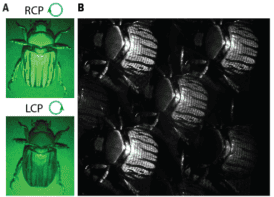
Tiny particles of gold used in medical diagnostics, cosmetics and food can degrade inside biological cells despite the metal’s low reactivity, say researchers in France. The result, which contradicts earlier assumptions, proves that cells can metabolize gold even though the element is not essential for their function.
Gold in various forms has been used in medicine since antiquity. Thanks to the metal’s unique optical properties, gold nanoparticles are today used in several therapeutic applications, including photothermal therapy and radiotherapy. They are also useful in diagnostic techniques such as photoacoustic imaging and two-photon luminescence.
Once ingested or absorbed through the skin, gold nanoparticles mostly end up in the liver and spleen. There, they are internalized by macrophages and sequestered inside lysosomes – the “waste recycling centre” of cells. Although little was known about their long-term fate, gold’s status as a “noble” metal – that is, chemically inert – suggested that the nanoparticles would remain intact within these cellular structures for indefinite periods.
Now, however, a team led by Florence Gazeau and Florent Carn from the University of Paris, Sorbonne University and the University of Strasbourg has proved otherwise. The researchers tracked how gold nanoparticles measuring 4 to 22 nm in diameter evolve inside cells over a period of six months. In their work, they studied what happens to the particles inside primary fibroblasts. This is a type of cell that is ubiquitous in the body and that has a low proliferation rate. This means that the nanoparticles can remain in the same cell for long periods and so be followed over a period of several months.
“Significant transformations”
Thanks to a combination of electron microscopy imaging and measurements of the expression of 18000 genes, Gazeau, Carn and colleagues found that the nanoparticles undergo significant transformations after just a few weeks.

Targeting cancer with gold nanoparticles is just the start…
For example, the smallest nanoparticles are degraded first by an enzyme called NADPH oxidase, which produces highly oxidizing reactive oxygen species in the lysosome. The researchers also observed a recrystallization process in which biomineralized gold particles 2.5 nm in size self-assemble into leaf-shaped nanostructures. Such structures had previously been observed in patients with rheumatoid polyarthritis who had been treated with ionic gold or “gold salts”.
The researchers suggest that because of this similarly, gold salts and gold nanoparticles may share the same metabolism of degradation. This unexpected result could help clinicians better evaluate the toxicity of these particles in the future and determine how the body eliminates them. The study also shows that gold, whatever its initial form, can be metabolized by mammals despite not being necessary for their survival, they add.
The research is detailed in PNAS.



